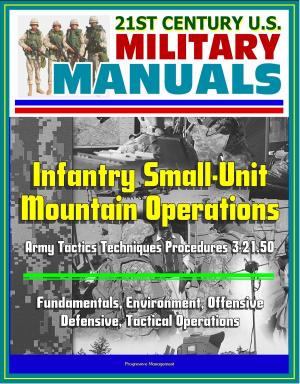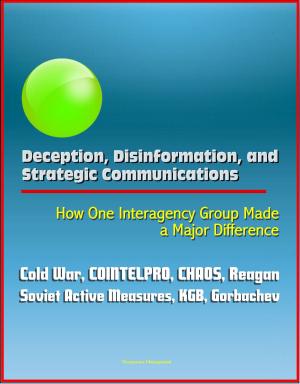History of the Joint Chiefs of Staff: Volume IV: The Joint Chiefs of Staff and National Policy 1950 - 1952, Mossadegh and Iran, Rearmament, Armageddon, Atomic Arsenal, World War III, NATO
Nonfiction, History, Asian, Korean War, Military, United States| Author: | Progressive Management | ISBN: | 9781301194933 |
| Publisher: | Progressive Management | Publication: | September 19, 2013 |
| Imprint: | Smashwords Edition | Language: | English |
| Author: | Progressive Management |
| ISBN: | 9781301194933 |
| Publisher: | Progressive Management |
| Publication: | September 19, 2013 |
| Imprint: | Smashwords Edition |
| Language: | English |
This volume describes the impact of the Korean War upon national security policies and programs. The Soviet Union's willingness to sanction overt aggression, in an area where Soviet security interests were only marginally involved, seemed to show that Moscow might indeed have a master plan for world domination. That helped force a fundamental change in the Truman administration's estimates of US security needs. The first six chapters describe the consequences for the US military establishment—the launching of rearmament and the pacing of the subsequent build-up. The last seven chapters outline the efforts made to create a collective security structure by galvanizing the North Atlantic Treaty Organization (NATO), beginning German rearmament, encouraging formation of a Middle East Command, protecting Taiwan, supporting France in Indochina, and concluding peace and security treaties with Japan, the Philippines, Australia, and New Zealand.
- Rearmament versus Retrenchment (1950) * 2. Rearmament Begun (1950) * 3. Rearmament Sustained (1951) * 4. Rearmament Retarded (1952) * 5. The Approach of Armageddon: Atomic Arsenal * 6. The Approach of Armageddon: Strategic Planning * 7. NATO in Alarm: 1950 * 8. NATO in Expansion: 1951 * 9. NATO in Climax: 1951-1952 * 10. NATO in Relapse: 1952 * 11. The Middle East: "Recessional" * 12. The Far East: Nationalism, Communism, and Containment * 13. The Resurrection of Japan
Contents * 1. Rearmament versus Retrenchment (1950) * Introduction: The Mid-Century World * A Plea for Rearmament: NSC 68 * A Rationale for Retrenchment: The FY 1951 Budget * The Battle in Balance: The FY 1952 Budget * Recapitulation * 2. Rearmament Begun (1950) * Motif * Meeting the Korean Emergency: Force and Budget Increases * Defining the Danger: NSC 73/4 * Galvanizing Rearmament: NSC 68/1 and 68/2 * General Marshall Succeeds Louis Johnson * Intermezzo * Crescendo: NSC 68/4 * 3. Rearmament Sustained (1951) * "Time Is On Our Side.." * Presentation of the FY 1952 Budget: Implementing NSC 68/4 * Reviewing Rearmament: NSC 114/1 * Air Power Wins Primacy * Formulating the FY 1953 Budget: NSC 114/2 * Robert Lovett Replaces General Marshall * 4. Rearmament Retarded (1952) * Reducing the FY 1953 Budget * Dissonance: NSC 135/3 and the FY 1954 Budget * Reprise: NSC 141 * Coda: NSC 142 * 5. The Approach of Armageddon: Atomic Arsenal * Advent of the Nuclear Age * Expansion of the Arsenal * Custody and Stockpiling Controversies * 6. The Approach of Armageddon: Strategic Planning * World War III: 1950-1952 * The Atomic Offensive * Bombers and Bases * World War III: 1954 * New Program for Planning * 7. NATO in Alarm: 1950 * Origins of the Alliance * The State of NATO in Mid-1950 * The Impact of Korea * The Genesis of German Rearmament * September Stalemate * The Pleven Plan * The Brussels Solution * 8. NATO in Expansion: 1951 * The "Great Debate" * The Establishment of SHAPE * The Reorganization of NATO * The Atlantic and Mediterranean Commands: Decisions Deferred * Attenuation of the Medium Term Defense Plan * The Abortive Foreign Ministers' Meeting * The European Army and German Rearmament * 9. NATO in Climax: 1951-1952 * The Washington Foreign Ministers' Meeting * From Ottawa to Rome * The Temporary Council Committee Report * Atlantic Command Achieved * An Impending Crisis * The Lisbon Meeting * 10. NATO in Relapse: 1952 * The Faltering Force * The Annual Review * Debating the "Continental" Strategy * The Mediterranean Command Solution * Franco and NATO * Erosion of the EDC * Retrospect * 11. The Middle East: "Recessional" * The Ending of an Empire * Egypt and the Middle East Command * The Suez Complication * Aid to Egypt? * The Iranian Imbroglio * The Shortcomings of Strategic Planning * Access to Oil * 12. The Far East: Nationalism, Communism, and Containment * Asia Awakens * Taiwan: Sanctuary or Springboard? * The Indochina Quagmire * Insurgency in the Philippines * 13. The Resurrection of Japan
This volume describes the impact of the Korean War upon national security policies and programs. The Soviet Union's willingness to sanction overt aggression, in an area where Soviet security interests were only marginally involved, seemed to show that Moscow might indeed have a master plan for world domination. That helped force a fundamental change in the Truman administration's estimates of US security needs. The first six chapters describe the consequences for the US military establishment—the launching of rearmament and the pacing of the subsequent build-up. The last seven chapters outline the efforts made to create a collective security structure by galvanizing the North Atlantic Treaty Organization (NATO), beginning German rearmament, encouraging formation of a Middle East Command, protecting Taiwan, supporting France in Indochina, and concluding peace and security treaties with Japan, the Philippines, Australia, and New Zealand.
- Rearmament versus Retrenchment (1950) * 2. Rearmament Begun (1950) * 3. Rearmament Sustained (1951) * 4. Rearmament Retarded (1952) * 5. The Approach of Armageddon: Atomic Arsenal * 6. The Approach of Armageddon: Strategic Planning * 7. NATO in Alarm: 1950 * 8. NATO in Expansion: 1951 * 9. NATO in Climax: 1951-1952 * 10. NATO in Relapse: 1952 * 11. The Middle East: "Recessional" * 12. The Far East: Nationalism, Communism, and Containment * 13. The Resurrection of Japan
Contents * 1. Rearmament versus Retrenchment (1950) * Introduction: The Mid-Century World * A Plea for Rearmament: NSC 68 * A Rationale for Retrenchment: The FY 1951 Budget * The Battle in Balance: The FY 1952 Budget * Recapitulation * 2. Rearmament Begun (1950) * Motif * Meeting the Korean Emergency: Force and Budget Increases * Defining the Danger: NSC 73/4 * Galvanizing Rearmament: NSC 68/1 and 68/2 * General Marshall Succeeds Louis Johnson * Intermezzo * Crescendo: NSC 68/4 * 3. Rearmament Sustained (1951) * "Time Is On Our Side.." * Presentation of the FY 1952 Budget: Implementing NSC 68/4 * Reviewing Rearmament: NSC 114/1 * Air Power Wins Primacy * Formulating the FY 1953 Budget: NSC 114/2 * Robert Lovett Replaces General Marshall * 4. Rearmament Retarded (1952) * Reducing the FY 1953 Budget * Dissonance: NSC 135/3 and the FY 1954 Budget * Reprise: NSC 141 * Coda: NSC 142 * 5. The Approach of Armageddon: Atomic Arsenal * Advent of the Nuclear Age * Expansion of the Arsenal * Custody and Stockpiling Controversies * 6. The Approach of Armageddon: Strategic Planning * World War III: 1950-1952 * The Atomic Offensive * Bombers and Bases * World War III: 1954 * New Program for Planning * 7. NATO in Alarm: 1950 * Origins of the Alliance * The State of NATO in Mid-1950 * The Impact of Korea * The Genesis of German Rearmament * September Stalemate * The Pleven Plan * The Brussels Solution * 8. NATO in Expansion: 1951 * The "Great Debate" * The Establishment of SHAPE * The Reorganization of NATO * The Atlantic and Mediterranean Commands: Decisions Deferred * Attenuation of the Medium Term Defense Plan * The Abortive Foreign Ministers' Meeting * The European Army and German Rearmament * 9. NATO in Climax: 1951-1952 * The Washington Foreign Ministers' Meeting * From Ottawa to Rome * The Temporary Council Committee Report * Atlantic Command Achieved * An Impending Crisis * The Lisbon Meeting * 10. NATO in Relapse: 1952 * The Faltering Force * The Annual Review * Debating the "Continental" Strategy * The Mediterranean Command Solution * Franco and NATO * Erosion of the EDC * Retrospect * 11. The Middle East: "Recessional" * The Ending of an Empire * Egypt and the Middle East Command * The Suez Complication * Aid to Egypt? * The Iranian Imbroglio * The Shortcomings of Strategic Planning * Access to Oil * 12. The Far East: Nationalism, Communism, and Containment * Asia Awakens * Taiwan: Sanctuary or Springboard? * The Indochina Quagmire * Insurgency in the Philippines * 13. The Resurrection of Japan















